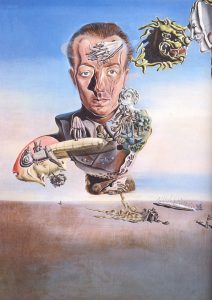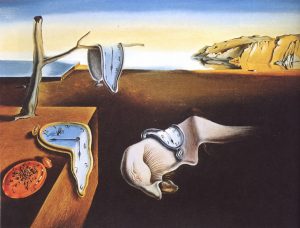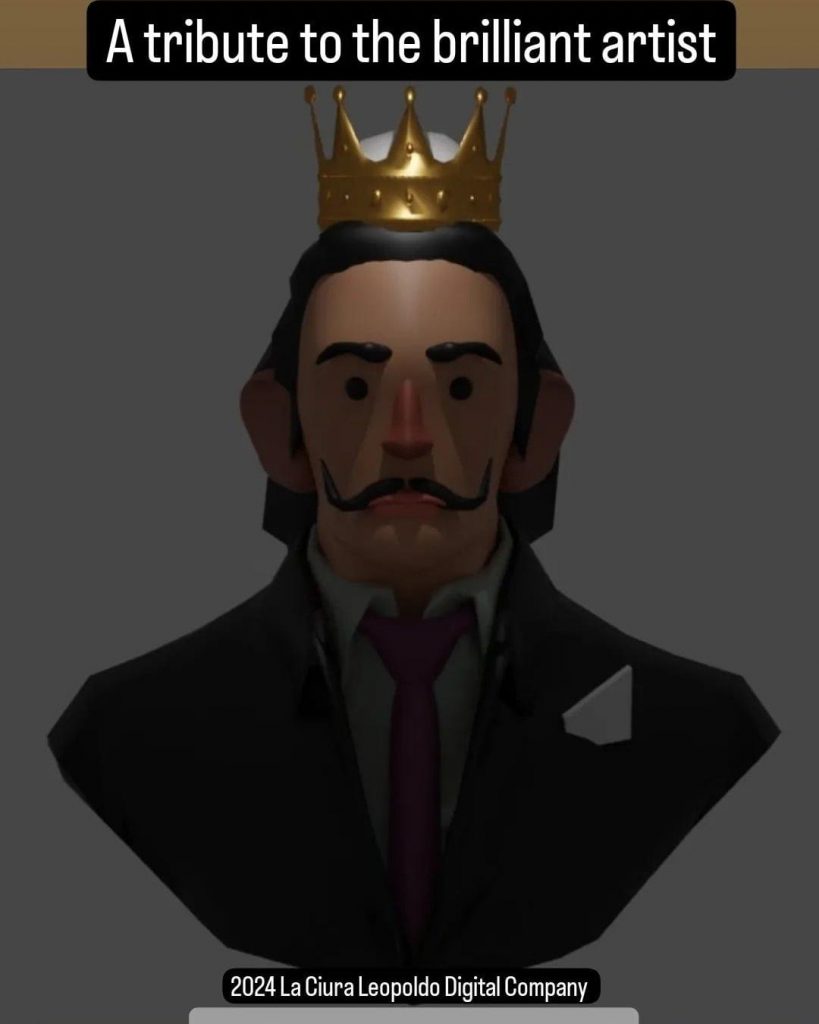Salvador Dalí, born on May 11, 1904 in Figueras, Spain, and died in the same city on January 23, 1989, is one of the most famous surrealist artists. Dalí is known for his technical skill, his precise drawing, and the surprising and bizarre images present in his works.
Dalí received his formal artistic training in Madrid, where he assimilated a wide range of artistic styles and showed extraordinary technical skill as a painter. However, it was not until the late 1920s that two events led to the development of his mature artistic style: the discovery of Sigmund Freud’s writings on the erotic importance of subconscious images and his affiliation with the surrealists in Paris.
Dalí is known for having painted a dreamlike world in which common objects are juxtaposed, deformed, or otherwise metamorphosed in a bizarre and irrational way. He portrayed these objects with meticulous detail, almost painfully realistic, and usually placed them within desolate sunny landscapes reminiscent of his native Catalonia.
Perhaps Dalí’s most enigmatic image is “The Persistence of Memory” (1931), in which melted clocks rest in a spectrally calm landscape. This work has become one of the most famous surrealist paintings.
Dalí lived in France during the Spanish Civil War (1936-1939) before leaving for the United States in 1940, where he achieved commercial success. He returned to Spain in 1948, where he announced his return to the Catholic faith and developed his style of “nuclear mysticism”, based on his interest in classicism, mysticism, and recent scientific developments.
Dalí’s artistic repertoire was vast: it included painting, sculpture, film, graphic arts, animation, fashion, and photography, sometimes in collaboration with other artists. He also wrote fiction, poetry, autobiography, essays, and criticism…
The meeting between two great creative minds, the famous project between Salvador Dalí and Walt Disney, is a unique and fascinating collaboration, almost mystical, in the world of art and animation. The result of this brilliant collaboration is an animated short film called “Destino”.
“Destino” was conceived in 1945 and represents a charming surreal fairy tale. Although it was designed during World War II, the short remained incomplete for more than fifty years. During this period, Dalí worked on the images together with John Hench, while Mexican composer Armando Dominguez wrote the music and Walt Disney handled the production.
The short remained incomplete due to the economic crisis resulting from the war, which forced Disney to halt production. However, the idea was so ambitious that it survived in the Morgue, the purgatory-archive where Disney keeps all unfinished projects.
Only fifty years later, thanks to the contribution of Roy Edward Disney, Walt’s nephew, the drafts of the short were found and restored. Twenty-five animators worked on the drafts of symbolic and romantic images, but also cryptic and incomprehensible. By integrating traditional drawings with some digital elements, “Destino” became a surreal animated film.
“Destino” tells a love story through an exceptional dreamlike journey. It is a perfect example of how the art of the great surrealist Dalí met the imagination of the father of cinematic animation, Walt Disney.
Even after many years, we can say that Dalí’s genius is more modern than one might think. Having combined his art for the realization of an animated short is more a thing of today. This shows how far ahead his creative mind was and suggests that Dalí could also be artistically placed in today’s world, where anime and manga have become a popular mass artistic product.
“the artistic technique” :
The “paranoiac-critical method” is a creative style/technique developed by Dalì in the 1930s. It is based on the concept of inducing a paranoid state to optimize and maximize the creative process, this step is called “paranoia”. The figures, elaborated from Dalì’s unconscious, were reported on canvas (this is called the critical phase). This creative process allowed Dalì to make his thoughts tangible by “projecting” them materially onto the canvas and making the concept strongly expressive thanks to his figurative or hyperrealistic painting style that many of you know.
“There is only one difference between a madman and me. The madman thinks he is sane. I know I am mad.” — Salvador Dalí

The painting “Portrait De Paul Eluard” (“the image above”) the record for being the most expensive Salvador Dalì artwork ever sold. This extraordinary piece of art was auctioned off for the staggering amount of £13.5 million at Sotheby’s in London in 2011. This event marked a historic moment in the art market, highlighting Dalì’s enduring importance and influence in the global artistic landscape.

“The Persistence of Memory” is an iconic artwork created by the renowned surrealist artist Salvador Dalí. This masterpiece, painted in oil on a 24×33 cm canvas, was crafted in 1931. Today, it is proudly displayed at the Museum of Modern Art in New York, where it continues to enchant and inspire visitors with its unique and provocative vision.
If you want to better understand his thought process, I recommend one of his diaries, called “Diary of a Genius”, one of my favorite books. This autobiographical book can be found on Amazon.
Diary of a Genius by Salvador Dali (1988-07-30): Amazon.co.uk: Books

